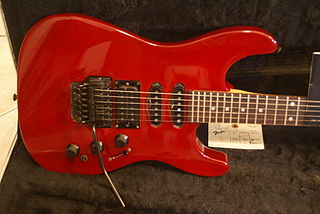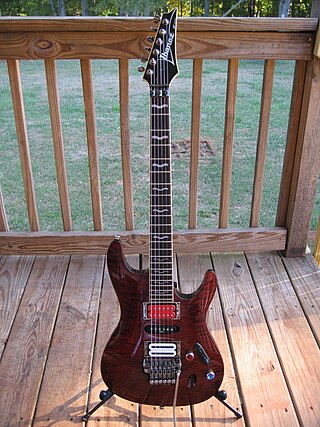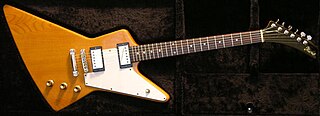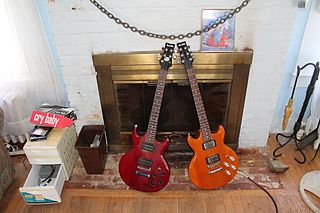Ibanez is a Japanese guitar brand owned by Hoshino Gakki. Based in Nagoya, Aichi, Japan, Hoshino Gakki were one of the first Japanese musical instrument companies to gain a significant foothold in import guitar sales in the United States and Europe, as well as the first brand of guitars to mass-produce seven-string and eight-string guitars. Ibanez manufactures effects, accessories, amps, and instruments in Japan, China, Indonesia, and the United States. As of 2017 they marketed nearly 165 models of bass guitar, 130 acoustic guitars, and more than 300 electric guitars. After Gibson and Fender, Ibanez is considered the third biggest guitar brand.

The Gibson EDS-1275 is a double neck Gibson electric guitar introduced in 1963 and still in production. Popularized and raised to iconic status by musicians such as John McLaughlin and Jimmy Page, it was called "the coolest guitar in rock".

Superstrat is a name for an electric guitar design that resembles a Fender Stratocaster but with differences that clearly distinguish it from a standard Stratocaster, usually to cater to a different playing style. Differences typically include more pointed, aggressive-looking body and neck shapes with increased cutaways to facilitate access to the higher frets, an increased number of frets on the fingerboard, a contoured heel at the neck joint facilitating easier higher fret access, the usage of humbucking pickups, and locking vibrato systems, most commonly the Floyd Rose.
Washburn Guitars is an American brand and importer of guitars, mandolins, and other string instruments, originally established in 1883 in Chicago, Illinois. The Washburn name is controlled by U.S. Music Corp., a subsidiary of Canadian corporate group Exertis|JAM.

The Gibson Explorer is a type of electric guitar model by Gibson guitars, released in 1958. The Explorer offered a radical, "futuristic" body design, much like its siblings: the Flying V, which was released the same year, and the Moderne, which was designed in 1957 but not released until 1982. The Explorer was the final development of a prototype design that, years later, Gibson marketed under the name Futura.
Fernandes Guitars is a guitar brand of Japanese marketing company Fernandes Co. Ltd. It is one of two guitar brands belonging to the company, the other being Burny Guitars which are Gibson guitar replicas. Its parent company originated in 1969 as Saito Musical Instruments before changing its name to Fernandes in 1972. The company started as a distributor of flamenco guitars sub-contracting to Japanese factories to build them. As the company grew, it expanded production to include electric guitars, bass guitars, amplifiers, and accessories to become one of the biggest guitar producers in Japan. Early manufacturing was done by Kawai Gakki who had guitar building experience from their acquisition of Teisco in 1967. Other major Japanese manufacturers have built guitars for Fernandes under original equipment manufacturer (OEM) arrangements, including Matsumoku, Dyna Gakki, and Tōkai Gakki. From the late 1980s, lower-spec guitars were also been built in Korea and more recently China.
The King V is an electric guitar model made by Jackson Guitars.

The Jackson Dinky is a Superstrat-style double-cutaway electric guitar built by Jackson Guitars. The "Dinky" is named for its slightly smaller than normal (7/8) body size. Usually fitted with a two humbucker pickup configuration, some models also include single-coil pickups and/or just one bridge humbucker. The fretboard can be made out of ebony, rosewood and more recently maple, or rock maple, with 24 jumbo frets and is always built with a bolt-on neck. Most of the guitars have a Floyd Rose original or licensed tremolo, and a locking nut to help maintain stable tuning. Some Dinkys have hardtail, or String-Thru bridges. The Jackson Dinky is usually preferred by players of hard rock and heavy metal.

The Ibanez RG is a series of electric guitars produced by Hoshino Gakki. The first model in the series, the RG550, was originally released in 1987 and advertised as part of the Roadstar series. That series was renamed "RG" in 1992 and all models since are simply known as RGs.

Caparison Guitars is a Japanese-origin manufacturer of electric guitars. The company is headquartered in Japan and is a subsidiary of Caparison Guitar Company Ltd., based in the United Kingdom.
Matsumoku Industrial was a Japanese manufacturing company based in Matsumoto, Nagano, between 1951 and 1987. Established in 1951 as a woodworking and cabinetry firm, Matsumoku is remembered as a manufacturer of guitars and bass guitars, including some Epiphone and Aria guitars.

Greco is a Japanese guitar brand owned by the Kanda Shokai Corporation (in Japanese) 神田商会, a musical instrument wholesaler mostly known for being part of Fender Japan. Instruments manufactured with the name "Greco" are electric and acoustic guitars.
Burny is a brand of electric guitars produced by Fernandes Guitars. Initially used on their range of Gibson replica guitars, the Burny brand was also used as a name on some of their 1970s Stratocaster copies and later used as a brand line for original designs.

The Ibanez S Series is a guitar series produced by Hoshino Gakki. Introduced in the late 1980s, the S Series is notable for being a streamlined mahogany-bodied guitar with a maple neck that plays comfortably while retaining the resonance of mahogany. Like the RG series, it also has prestige models, as well as derivatives, namely the SZ, SV, and SA series.

The Destroyer is an Ibanez brand electric guitar model (originally) manufactured at the FujiGen musical instrument factory for the Hoshino Gakki Company. The Destroyer model was first introduced by Hoshino Gakki in 1975 and was based on the Gibson Explorer design. The Destroyer has since undergone several design and line changes and has been available in both 6-string and bass versions.

The Ibanez GIO Series is an affordable guitar series produced by Hoshino Gakki (Ibanez), replacing the Cimar line. The GIO line is intended as beginner models, similar to Fender's Squier guitars, and Gibson's Epiphone line. This series of guitars are produced in either China or Indonesia, depending on model.

The Ibanez Jet King is the term for a family of electric guitars sold by Ibanez. The family includes:
Penco was a brand of guitars owned and manufactured by the Hoshino Gakki Co. in its factory of Nagoya, Japan. Ibanez guitars was another brand owned and manufactured by Hoshino Gakki. In the United States, Penco guitars were distributed by the Philadelphia Music Company.

The Fender Precision Bass Lyte is a fretted model of electric bass manufactured by Fender Musical Instruments Corporation. This bass is characterized by its smaller modern C shape body, P-J pickup configuration, and light weight. The Precision Bass Lyte is equipped with 22 medium jumbo frets and has a scale length of 34 inches. Another relatively unique feature to the Lyte is the Pickup Pan knob which allows users to modulate the amount of the two pickups used. The Lyte is a sub-model of the Fender Precision Bass.















